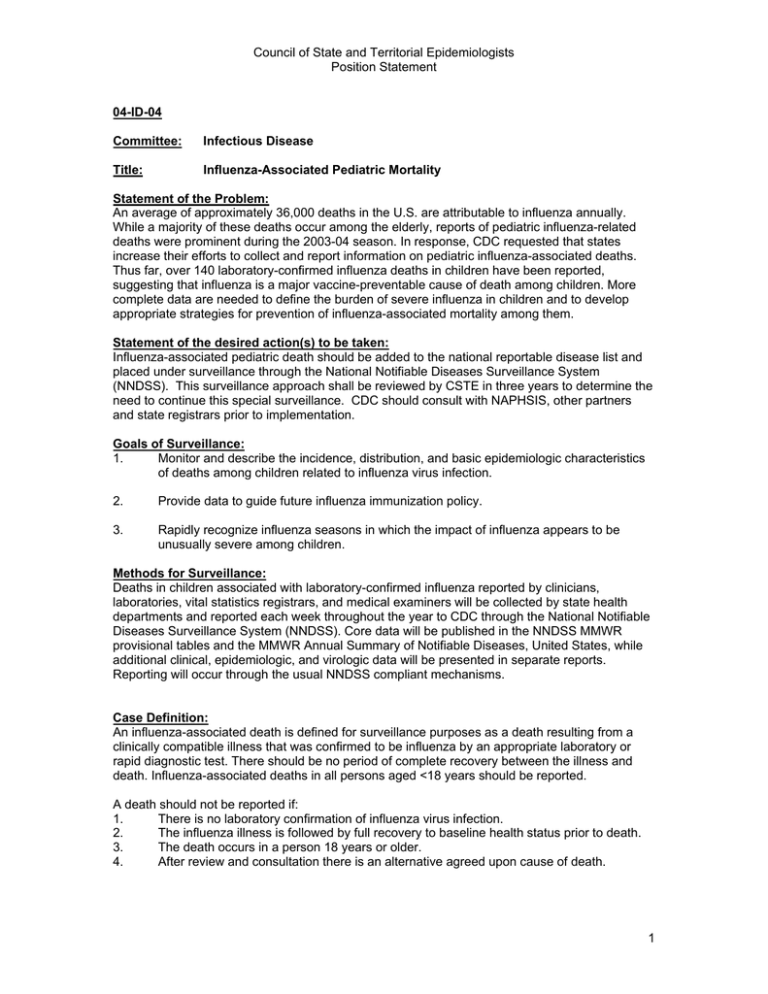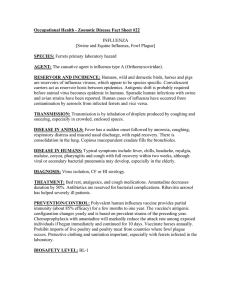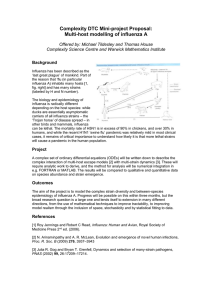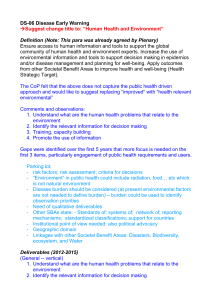Council of State and Territorial Epidemiologists Position Statement 04-ID-04
advertisement

Council of State and Territorial Epidemiologists Position Statement 04-ID-04 Committee: Infectious Disease Title: Influenza-Associated Pediatric Mortality Statement of the Problem: An average of approximately 36,000 deaths in the U.S. are attributable to influenza annually. While a majority of these deaths occur among the elderly, reports of pediatric influenza-related deaths were prominent during the 2003-04 season. In response, CDC requested that states increase their efforts to collect and report information on pediatric influenza-associated deaths. Thus far, over 140 laboratory-confirmed influenza deaths in children have been reported, suggesting that influenza is a major vaccine-preventable cause of death among children. More complete data are needed to define the burden of severe influenza in children and to develop appropriate strategies for prevention of influenza-associated mortality among them. Statement of the desired action(s) to be taken: Influenza-associated pediatric death should be added to the national reportable disease list and placed under surveillance through the National Notifiable Diseases Surveillance System (NNDSS). This surveillance approach shall be reviewed by CSTE in three years to determine the need to continue this special surveillance. CDC should consult with NAPHSIS, other partners and state registrars prior to implementation. Goals of Surveillance: 1. Monitor and describe the incidence, distribution, and basic epidemiologic characteristics of deaths among children related to influenza virus infection. 2. Provide data to guide future influenza immunization policy. 3. Rapidly recognize influenza seasons in which the impact of influenza appears to be unusually severe among children. Methods for Surveillance: Deaths in children associated with laboratory-confirmed influenza reported by clinicians, laboratories, vital statistics registrars, and medical examiners will be collected by state health departments and reported each week throughout the year to CDC through the National Notifiable Diseases Surveillance System (NNDSS). Core data will be published in the NNDSS MMWR provisional tables and the MMWR Annual Summary of Notifiable Diseases, United States, while additional clinical, epidemiologic, and virologic data will be presented in separate reports. Reporting will occur through the usual NNDSS compliant mechanisms. Case Definition: An influenza-associated death is defined for surveillance purposes as a death resulting from a clinically compatible illness that was confirmed to be influenza by an appropriate laboratory or rapid diagnostic test. There should be no period of complete recovery between the illness and death. Influenza-associated deaths in all persons aged <18 years should be reported. A death should not be reported if: 1. There is no laboratory confirmation of influenza virus infection. 2. The influenza illness is followed by full recovery to baseline health status prior to death. 3. The death occurs in a person 18 years or older. 4. After review and consultation there is an alternative agreed upon cause of death. 1 Council of State and Territorial Epidemiologists Position Statement Laboratory criteria for diagnosis: Laboratory testing for influenza virus infection may be done on pre- or post-mortem clinical specimens, and include identification of influenza A or B virus infections by a positive result by at least one of the following: * Influenza virus isolation in tissue cell culture from respiratory specimens * Reverse-transcriptase polymerase chain reaction (RT-PCR) testing of respiratory specimens * Immunofluorescent antibody staining (direct or indirect) of respiratory specimens * Rapid influenza diagnostic testing of respiratory specimens * Immunohistochemical (IHC) staining for influenza viral antigens in respiratory tract tissue from autopsy specimens * Four-fold rise in influenza hemagglutination inhibition (HI) antibody titer in paired acute and convalescent sera*. *Serologic testing for influenza is available in a limited number of laboratories, and should only be considered as evidence of recent infection if a four-fold rise in influenza (HI) antibody titer is demonstrated in paired sera. Single serum samples are not interpretable. Case Classification: Confirmed - A death meeting the clinical case definition that is laboratory confirmed. Laboratory or rapid diagnostic test confirmation is required as part of the case definition; therefore, all reported deaths will be classified as confirmed. Period of Surveillance: Indefinite, with periodic review of reporting needs. Reporting anticipated to begin the week ending October 9, 2004, and continue throughout the year. States may begin participating as soon as this condition is made notifiable in their state. Background and Justification: Influenza in children can present with fever, respiratory, and/or gastrointestinal symptoms. Serious complications of influenza in children include pneumonia, respiratory failure, nonrespiratory conditions such as shock and encephalopathy, and exacerbations of underlying chronic illness. Death associated with influenza can be directly related to the primary viral infection, or can result from a secondary complication. In certain cases, the progression from onset of illness to death can occur rapidly. An average of approximately 36,000 deaths in the U.S. are attributable to influenza annually. Deaths in children comprise a small percentage of all influenza-associated deaths, and estimates of pediatric influenza mortality are therefore much less precise than those for adults. Limited studies indicate, however, that young children are at increased risk for hospitalization related to influenza. During the fall of 2003, there were several widely publicized reports of influenza-associated deaths in children. These accounts generated concern that children were disproportionately affected by influenza during the current season. In December 2003, CDC requested that states voluntarily report influenza-associated deaths in children <18 years of age during the 2003-04 season. During October 11, 2003 - March 22, 2004, CDC received a total of 142 reports of pediatric fatalities associated with laboratory-confirmed influenza. Whether this represents an increase over baseline is unclear, since comparative data do not exist. In addition, a heightened awareness of severe complications and deaths associated with influenza and the increased availability of testing may have contributed to the identification of more influenza-associated fatalities. Further, of these reported deaths, a significant number were 2 years of age or older and had no medical conditions recognized as high risk for influenza-related complications. Thus, these 2 Council of State and Territorial Epidemiologists Position Statement children were not among any groups currently targeted for influenza vaccination. Additional information is needed to further characterize those children at increased risk of influenza-related complications and deaths and to reassess current vaccination recommendations based on such information. This information could influence influenza vaccine policy by identifying specific pediatric groups at high risk for influenza-associated death or by providing data to support the expansion of pediatric age groups for targeted influenza vaccination. Surveillance of influenza-associated pediatric deaths will serve to complement the current national influenza surveillance strategies. By including this element in the national reporting system, basic population-based epidemiologic characteristics, such as incidence, age and geographic distribution can be determined. The collection of selected clinical information could potentially describe uncommon or previously unrecognized presentations, possible risk factors, and the impact of influenza vaccination. Linkage of mortality data with virologic and other laboratory data may provide information on strain virulence and abnormal host responses, and may guide vaccine strain selection. Coordination: Agencies for Response: (1) Julie L. Gerberding Director, Centers for Disease Control and Prevention 1600 Clifton Road, NE, Mailstop D-14 Atlanta, GA 30333 Telephone: (404) 639-7000 Email: JGerberding@cdc.gov Agencies for Information: (1) George E. Hardy, MD, MPH Executive Director, Association of State and Territorial Health Officers 1275 K Street NW, Suite 800 Washington, DC 20005 Telephone: (202) 371-9090 Email: Ghardy@astho.org (2) Scott Becker Executive Director Association of Public Health Laboratories 2025 M Street NW, #550 Washington, DC 20036-3320 Telephone: (202) 822-5227 Email: Sbecker@aphl.org (3) Michael Tapper, MD President, Society of Healthcare Epidemiology of America 19 Mantua Road Mt. Royal, NJ 08061 Telephone: (856) 423-0087 Email: MTapper@lenoxhill.net (4) James G. Masland Executive Director, Association for Professionals in Infection Control and Epidemiology, Inc. 1275 K Street NW, Suite 1000 Washington, DC 20005-4006 Telephone: (202) 789-1890 3 Council of State and Territorial Epidemiologists Position Statement Email: JMasland@apic.org (5) Michael Graham, MD President, National Association of Medical Examiners 1300 Clark Avenue St. Louis, MO 63101-2718 Telephone: (314) 622-4971 Email: grahamma@slu.edu (6) Jody Henry Hershey, MD, MPH President, National Association of County and City Health Officials Director, New River Health District 210 S. Pepper Street, Suite A Christiansburg, VA 24073 Telephone: (540) 381-7100, Ext. 156 Fax: (540) 381-7108 Email: jhershey@vdh.state.va.us (7) Steven Schwartz, PhD President, National Association for Public Health Statistics and Information Systems 801 Roeder Road, Suite 650 Silver Spring, MD 20910 Telephone: (301) 563-6001 Fax: (301) 563-6012 Email: sschawrt@health.nyc.gov Submitting Author: (1) Kathleen F. Gensheimer MD, MPH State Epidemiologist and Director of Medical Epidemiology Division of Disease Control Maine Bureau of Health 11 State House Station Augusta, ME 04333 Telephone: (207) 287-5183 Email: Kathleen.F.Gensheimer@maine.gov Co-Author: (1) Keiji Fukuda, MD, MPH Influenza Branch Division of Viral and Rickettsial Diseases National Center for Infectious Disease Centers for Disease Control and Prevention 1600 Clifton Road, NE, Mailstop A-32 Atlanta, GA 30333 Telephhone: (404) 639-3747 Email: KFukuda@cdc.gov 4 Council of State and Territorial Epidemiologists Position Statement References: Centers for Disease Control and Prevention. Severe morbidity and mortality associated with influenza in children and young adults--Michigan, 2003. Morb Mortal Wkly Rep 52(35): 837-40. Centers for Disease Control and Prevention. Update: influenza-associated deaths reported among children aged <18 years --- United States, 2003—04 Influenza Season. MMWR 2004;52(53):1286--8. Chiu SS, et al. Influenza-related hospitalizations among children in Hong Kong. N Engl J Med 2002;347:2097-103. Izurieta HS, et al. Influenza and the rates of hospitalization for respiratory disease among infants and young children. N Engl J Med 2000;342:232-9. Neuzil KM, et al. The effect of influenza on hospitalizations, outpatient visits, and courses of antibiotics in children. N Engl J Med 2000;342:225-31. Quach C, et al. Risk factors associated with severe influenza infections in childhood: implication for vaccine strategy. Pediatrics 2003;112:e197-e201. Thompson WW, et al. Mortality associated with influenza and respiratory syncytial virus in the United States. JAMA 2003;289:179-186. 5


